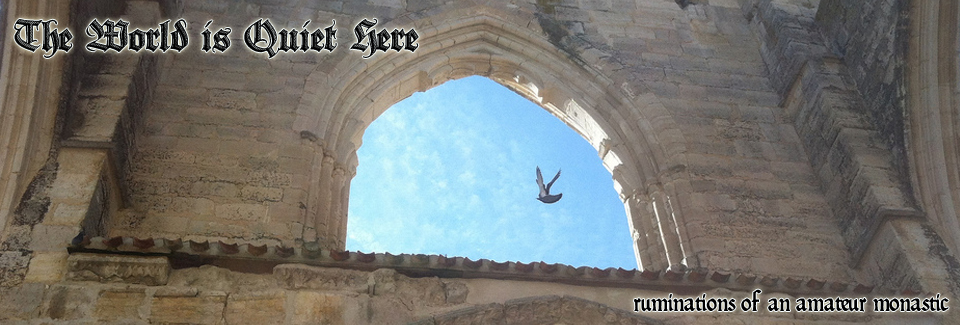Trinity Sunday: Scutum Fidei

In Saint Patrick Church in Tacoma – the place where I was Baptized, Confirmed, and Married – there are all sorts of Christian symbols painted on the walls. One that always set my brain to thinking looked something like this:

It is, of course, a Trinitarian symbol, reminding us in a visual way that while the Father is God, and the Son is God, and the Holy Spirit is God, the Father is not the Son is not the Holy Spirit.
It turns out that this is a very old symbol indeed. Here’s a version from the middle of the 13th Century:

It is called Scutum Fidei, or “the Shield of Faith”1, and there are numerous variations on it going back into the medieval era.
Today is a good day to contemplate the mysteries of the Trinity, for today the Church celebrates the Solemnity of the Most Holy Trinity, the first of two major feasts that begin the main part of the liturgical season known as Ordinary Time, or Tempus per annum (literally “time through the year”)2.
The Blessed Trinity is the foundational dogma on which everything in Christianity is based, and it is one of the most mysterious. Saint Thomas Aquinas would have us believe that many of the truths of Christianity can be deduced logically from observation of the world – but the Trinity could never be discovered. The Trinity must be revealed.
Indeed, it is Christ Himself who reveals the Trinity to us, commanding us to Baptize in the name of the Father and the Son and the Holy Spirit3. Since the dogma of the Blessed Trinity is revealed to us, we cannot hold it through logic but only by faith.
The Trinity reveals God as a relationship between the Three Divine Persons, and this is foundational to the understanding of God as love: “God is love, and he who abides in love abides in God, and God abides in him”4.
This dogma is so foundational, that Catholic (and Orthodox) prayers always begin by invoking the Blessed Trinity, both in words and by the reinforcing physical action of making the sign of the cross upon ourselves.

One of the oldest Christian prayers, dating back to Apostolic times, is the doxology Gloria Patri:
GLORIA Patri, et Filio, et Spiritui Sancto. Sicut erat in principio, et nunc, et semper, et in sæcula sæculorum. Amen.
GLORY be to the Father, and to the Son, and to the Holy Spirit. As it was in the beginning, is now, and will be forever. Amen.
What exactly is the dogma? The Catechism5 puts it this way:
253 The Trinity is One. We do not confess three Gods, but one God in three persons, the “consubstantial Trinity”. The divine persons do not share the one divinity among themselves but each of them is God whole and entire: “The Father is that which the Son is, the Son that which the Father is, the Father and the Son that which the Holy Spirit is, i.e. by nature one God.” In the words of the Fourth Lateran Council (1215), “Each of the persons is that supreme reality, viz., the divine substance, essence or nature.”
254 The divine persons are really distinct from one another. “God is one but not solitary.” “Father”, “Son”, “Holy Spirit” are not simply names designating modalities of the divine being, for they are really distinct from one another: “He is not the Father who is the Son, nor is the Son he who is the Father, nor is the Holy Spirit he who is the Father or the Son.” They are distinct from one another in their relations of origin: “It is the Father who generates, the Son who is begotten, and the Holy Spirit who proceeds.” The divine Unity is Triune.
255 The divine persons are relative to one another. Because it does not divide the divine unity, the real distinction of the persons from one another resides solely in the relationships which relate them to one another: “In the relational names of the persons the Father is related to the Son, the Son to the Father, and the Holy Spirit to both. While they are called three persons in view of their relations, we believe in one nature or substance.” Indeed “everything (in them) is one where there is no opposition of relationship.” “Because of that unity the Father is wholly in the Son and wholly in the Holy Spirit; the Son is wholly in the Father and wholly in the Holy Spirit; the Holy Spirit is wholly in the Father and wholly in the Son.”
Wow. Of the mysteries of our faith, this is the one that touches everything. So spend some time today in contemplation of this great ineffable Mystery, which is the basis of all the great Christian Creeds from the times of the Apostles until the present day.
The grace of the Lord Jesus Christ
(2 Corinthians 13:14)
and the love of God
and the fellowship of the Holy Spirit be with all of you.
Let it be your shield of faith.
For a fun look at how not to describe the Holy Trinity, can I recommend Saint Patrick’s Bad Analogies?
- cf. Ephesians 6:16
- Ordinary Time is actually split into two parts, the smaller one after Epiphany and the larger one after Pentecost.
- cf. Matthew 28:19
- 1 John 4:16
- I took out the plethora of footnotes, but you can read them in the Catechism if you’re curious.
